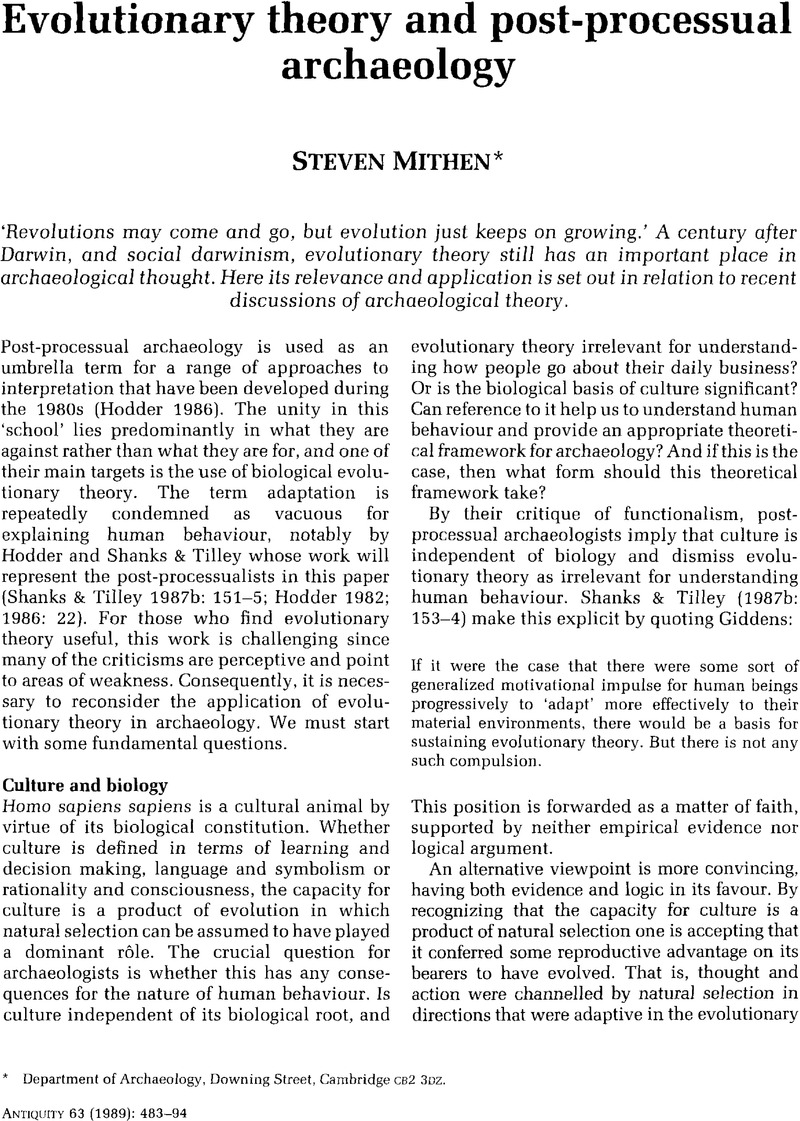Crossref Citations
This article has been cited by the following publications. This list is generated based on data provided by Crossref.
Thomas, Julian
1991.
The Hollow Men? A Reply to Steven Mithen.
Proceedings of the Prehistoric Society,
Vol. 57,
Issue. 2,
p.
15.
Mithen, S. J.
1991.
‘A Cybernetic Wasteland’? Rationality, Emotion and Mesolithic Foraging.
Proceedings of the Prehistoric Society,
Vol. 57,
Issue. 2,
p.
9.
Bird, C. F. M.
and
Frankel, David
1991.
Problems in constructing a prehistoric regional sequence: Holocene southeast Australia.
World Archaeology,
Vol. 23,
Issue. 2,
p.
179.
Bird, C.F.M.
and
Frankel, David
1991.
Chronology and explanation in western Victoria and south‐east South Australia.
Archaeology in Oceania,
Vol. 26,
Issue. 1,
p.
1.
Mithen, Steven J.
1991.
Ecological Interpretations of Palaeolithic Art..
Proceedings of the Prehistoric Society,
Vol. 57,
Issue. 01,
p.
103.
Saitta, Dean J.
1992.
Radical archaeology and middle-range methodology.
Antiquity,
Vol. 66,
Issue. 253,
p.
886.
Mithen, Steven
1993.
Individuals, Groups and the Palaeolithic Record: A Reply to Clark.
Proceedings of the Prehistoric Society,
Vol. 59,
Issue. ,
p.
393.
Cullen, Ben
1993.
The Darwinian Resurgence and the Cultural Virus Critique.
Cambridge Archaeological Journal,
Vol. 3,
Issue. 2,
p.
179.
Fletcher, Roland
1996.
Darwinian Archaeologies.
p.
61.
Ames, Kenneth M.
1996.
Darwinian Archaeologies.
p.
109.
Lyman, R. Lee
and
O'Brien, Michael J.
1997.
The Concept of Evolution in Early Twentieth‐Century Americanist Archaeology.
Archaeological Papers of the American Anthropological Association,
Vol. 7,
Issue. 1,
p.
21.
Flinn, Mark V.
1997.
Culture and the evolution of social learning.
Evolution and Human Behavior,
Vol. 18,
Issue. 1,
p.
23.
Spencer, Charles S.
1997.
Evolutionary approaches in archaeology.
Journal of Archaeological Research,
Vol. 5,
Issue. 3,
p.
209.
Mithen, Steven
1997.
Cognitive Archaeology, Evolutionary Psychology and Cultural Transmission, with Particular Reference to Religious Ideas.
Archaeological Papers of the American Anthropological Association,
Vol. 7,
Issue. 1,
p.
67.
Joyce, Arthur A.
1997.
Emergence and Change in Early Urban Societies.
p.
133.
Diblasi, Michael
1999.
Book Reviews.
Journal of Field Archaeology,
Vol. 26,
Issue. 1,
p.
89.
Neff, H.
2001.
International Encyclopedia of the Social & Behavioral Sciences.
p.
5007.
Lake, Mark
2001.
The Use of Pedestrian Modelling in Archaeology, with an Example from the Study of Cultural Learning.
Environment and Planning B: Planning and Design,
Vol. 28,
Issue. 3,
p.
385.
Hamilakis, Yannis
2001.
Environmental Archaeology: Meaning and Purpose.
Vol. 17,
Issue. ,
p.
29.
CUTTING, MARION
2003.
THE USE OF SPATIAL ANALYSIS TO STUDY PREHISTORIC SETTLEMENT ARCHITECTURE.
Oxford Journal of Archaeology,
Vol. 22,
Issue. 1,
p.
1.



